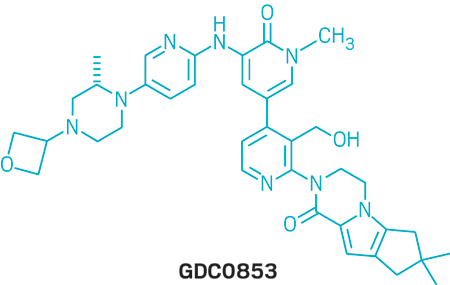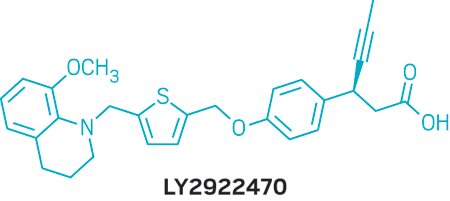Advertisement
Grab your lab coat. Let's get started
Welcome!
Welcome!
Create an account below to get 6 C&EN articles per month, receive newsletters and more - all free.
It seems this is your first time logging in online. Please enter the following information to continue.
As an ACS member you automatically get access to this site. All we need is few more details to create your reading experience.
Not you? Sign in with a different account.
Not you? Sign in with a different account.
ERROR 1
ERROR 1
ERROR 2
ERROR 2
ERROR 2
ERROR 2
ERROR 2
Password and Confirm password must match.
If you have an ACS member number, please enter it here so we can link this account to your membership. (optional)
ERROR 2
ACS values your privacy. By submitting your information, you are gaining access to C&EN and subscribing to our weekly newsletter. We use the information you provide to make your reading experience better, and we will never sell your data to third party members.
Pharmaceuticals
New drug candidates shine in San Diego
First-time disclosures symposium spotlights the process of developing clinical candidates
by Bethany Halford
April 11, 2016
| A version of this story appeared in
Volume 94, Issue 15
The Division of Medicinal Chemistry’s “First-Time Disclosures” symposium, where pharmaceutical companies unveil the structures of their clinical candidates, always draws a crowd. The symposium at the ACS national meeting in San Diego last month was no exception. Hundreds of attendees packed into a convention center room to get a peek at eight new drug candidates from seven different companies. Here, we feature the structures and some of the details presented.
AZD7594

Company: AstraZeneca
Target: Glucocorticoid receptor: When activated, this receptor regulates the expression of genes involved in the body’s immune system. Modulating it can reduce the inflammatory response that causes asthma.
Disease: Asthma, chronic obstructive pulmonary disorder (COPD)
Notes: This nonsteroidal compound is based on an earlier clinical candidate, AZD5423, which has the same indazole ether core. AZD7594, however, sits differently in the receptor’s binding pocket so that it may access a cavity where it takes advantage of polar interactions, reported Martin Hemmerling, a principal scientist with AstraZeneca.
VX984

Company: Vertex Pharmaceuticals
Target: Catalytic subunit of DNA-dependent protein kinase: This enzyme’s subunit interacts with the protein Ku to repair double-stranded DNA breaks. Blocking the interaction can enhance the efficacy of cancer treatments that induce this type of DNA damage.
Disease: Cancer
Notes: An earlier version of VX984 with hydrogens instead of deuteriums was metabolized too quickly, rendering it less effective. So Vertex scientists used deuterium to block metabolism by the enzyme aldehyde oxidase after classical medicinal chemistry approaches, such as adding steric bulk or replacing the protons that were being oxidized, yielded inferior compounds. Putting the deuterium in place of the hydrogen should slow aldehyde oxidase via the kinetic isotope effect, said John Maxwell, Vertex’s director of medicinal chemistry.
BMS986120

Company: Bristol-Myers Squibb
Target: Protease-activated receptor 4 (PAR4): PAR4 triggers human platelet activation via coagulation of the enzyme thrombin. So a compound that blocks PAR4 activity should prevent blood clots that form in patients with a condition known as thrombosis.
Disease: Thrombosis
Notes: Much of the work in this area has focused on family member PAR1, but recent work at BMS has validated PAR4 as an antithrombic drug target, making BMS986120 a first-in-class PAR4 antagonist, said Scott Priestley, senior principal scientist at BMS.
PF06650833

Company: Pfizer
Target: Interleukin-1 receptor associated kinase 4 (IRAK4): This kinase is important in innate immunity, and its inhibition is predicted to be beneficial in treating inflammatory diseases.
Disease: Rheumatoid arthritis, inflammatory bowel disorder
Notes: PF06650833 came from a screening assay that used nuclear magnetic resonance spectroscopy to determine binding between molecular fragments and IRAK4. The initial hit, which bound weakly to IRAK4, was optimized with structure- and property-based medicinal chemistry to generate a series of potent inhibitors, said Katherine Lee, an associate research fellow at Pfizer.
PF06650808

Company: Pfizer
Target: Neurogenic locus notch homolog protein 3 (NOTCH3): Activation and mutation of the NOTCH signaling pathway can lead to cancer.
Disease: Cancer
Notes: PF06650808 is an antibody-drug conjugate that delivers a cytotoxic payload molecule directly to tumor cells, explained Andreas Maderna, an associate research fellow at Pfizer. The payload molecule in PF06650808 was inspired by the marine natural product dolostatin 10, which is produced by cyanobacteria consumed by a type of sea slug.
GLPG1690

Company: Galapagos
Target: Autotaxin: This lysophospholipase enzyme is involved the production of bioactive lipid lysophosphatidic acid and has been reported as playing a role in several lung diseases.
Disease: Idiopathic pulmonary fibrosis, a lung tissue-scarring condition
Notes: GLPG1690 will soon be entering Phase II clinical trials for idiopathic pulmonary fibrosis, reported Nicolas Desroy, team leader for medicinal chemistry at Galapagos.
GDC-0853

Company: Genentech
Target: Bruton’s tyrosine kinase (BTK): This enzyme is important in B cell maturation and in regulating cells’ production of inflammatory compounds called cytokines, making it an attractive target for immunological disorders.
Disease: Rheumatoid arthritis, lupus
Notes: GDC-0853 appears to be active against a BTK mutant that researchers have identified in cancer patients who have relapsed on Imbruvica (ibrutinib), another drug that targets BTK. This suggests the compound could also be used in these cancer patients, noted Wendy Young, Genentech’s vice president of discovery chemistry.
LY2922470

Company:Eli Lilly & Co.
Target: G protein-coupled receptor 40 (GPR40): Also known as free fatty acid receptor 1, this protein is highly expressed in insulin-producing cells in the pancreas, called beta cells. When activated, this receptor leads to insulin secretion.
Disease: Type 2 diabetes
Notes: LY2922470 works with glucose to stimulate insulin secretion in animal models, reported Chafiq Hamdouchi, a senior research adviser at Lilly.




Join the conversation
Contact the reporter
Submit a Letter to the Editor for publication
Engage with us on Twitter